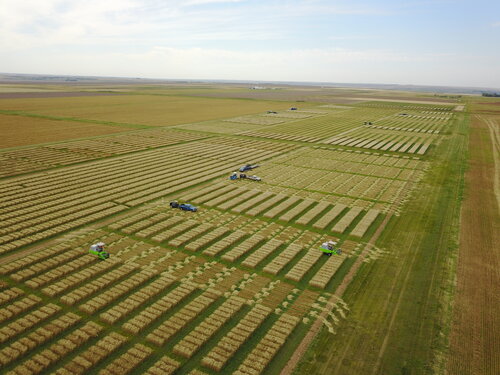Canada Western Red Spring (CWRS) Western Prairies for Drought and Heat Stress

Wheat producers face a variety of challenges that impact yield, grade, and farm operations. Richard Cuthbert, a wheat breeder with Agriculture and Agri-Food Canada, Swift Current Research Development Centre, says new wheat varieties can provide solutions to many of those challenges.
He’s trying to develop field-ready varieties of Canada Western Red Spring (CWRS) wheat for producers in the brown and dark brown soil zones (southern Alberta and southwestern Saskatchewan) that will respond to stresses in those regions—typically heat and drought.
“We see more extremes from year to year in terms of climate—moisture may be limited in some years and excessive in others,” he says. “We can’t predict what the environment will be, so we need varieties that can withstand a range of conditions.”
Creating something that adaptable brings significant challenges, explains Cuthbert, “but we’re fortunate to be working with improved genetics that have been bred over decades, maybe even a century, in Canada. We have a pretty good base to work from.”
Among the five priority-one diseases—Fusarium head blight (FHB), leaf rust, stem rust, stripe rust, and common bunt—Cuthbert says FHB and stripe rust are the biggest challenges.
“Stripe rust in particular has become a bigger concern in the Western Prairies in recent years,” he explains. “There seem to be new races that are able to withstand higher temperatures and may overwinter in Canada . . . That could be due to changing climates, but that’s just speculation. We know that stripe rust is persisting and is more prevalent.”
To have a fighting chance against rust, Cuthbert says farmers can’t rely on chemical controls alone. “We need genetics that will reduce farmers’ reliance on chemical controls. The fewer controls you need to use the better, from a profitability standpoint and from an environmental standpoint.”
He recently released a couple of new varieties that he’s very optimistic about. AAC Starbuck and AAC Wheatland are both semi-dwarf CWRS varieties with excellent grain yield, high protein, good straw strength, and tolerance to orange wheat blossom midge. AAC Starbuck also provides fewer FHB symptoms and lower accumulation of deoxynivalenol (DON), the mycotoxin produced by Fusarium species.
“They’re performing very well and the feedback is quite positive, so we’re optimistic for their launch this spring,” he says.
AAC Hockley is another new variety that came out last year. It’s not midge-resistant, but Cuthbert says it has an excellent disease resistance package, including improved FHB resistance.
Most breeding programs focus on resistance to the priority-one diseases, which is required for registration, but Cuthbert says his program has been maintaining resistance to loose smut as well.
“Doing the minimum is a good way to get in trouble, so we try to go above and beyond, especially with disease resistance,” he says. “Loose smut hasn’t been a concern in recent years, so it was removed from the breeding requirements, but we try to maintain it in our varieties so we don’t inadvertently introduce a susceptibility to the disease.”
Cuthbert’s new varieties are providing farmers with higher yields, assured performance, and a comprehensive disease resistance package. He projects that, by the end of the project, these new varieties could generate $100,000,000 in additional annual farm revenue.
This Wheat Cluster project received funding from Agriculture and Agri-Food Canada through the AgriScience Program, which is part of the Canadian Agricultural Partnership, a federal, provincial, territorial initiative. This project also received funding from Alberta Wheat Commission, Saskatchewan Wheat Development Commission, Manitoba Crop Alliance, and Western Grains Research Foundation.
For the project profile, CLICK HERE.